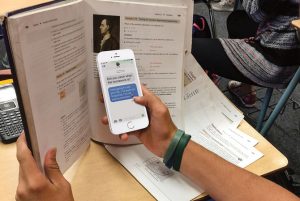
21st Century Adolescence: A Period of “Bright, Shiny Objects” and Disinformation
High School is a busy time in many regards. Adolescence brings with it a heighten level of emotional and social intensity that may or may not ever be replicated for the rest of their lives. Those early maturation years present as a challenge for most parents and educators who may be trying to impart learning to a generation who at no other time in history has been subjected to so much competing messaging based solely upon access to social media and the internet. Adolescents crave “bright, shiny objects” or an intensity of stimulation (Dahl, 2004) which is not necessarily conducive to deep investigative learning about everything that they are being asked to learn about in school. A constructivist approach to grabbing a teenager’s attention is to make the learning personal, meaningful and experiential, to trust students to intrinsically find their own truths. Intrinsic motivation is key to success, but it is a rare individual who in their adolescent years can be intrinsically curious about every subject in school. Most people understand that a public school education is the one environment wherein everyone in society is given an opportunity to learn the basic content knowledge that will produce a well-functioning society. What is perhaps being lost is that educators are having to do this in an age of not only “bright, shiny objects” but “bright, shiny disinformation”. We know, for example that; “Once acquired, false information is hard to dispel” (Froehlich, 2020), so is it wise for educators to trust an adolescent to think critically and effectively, to manage almost limitless information and evaluate it to a level that we expect, if we leave them to their own devices (literally and figuratively)?
Does Discovery Learning Lead to Gaps?

I’m finding that gaps in students’ understanding is becoming more pronounced. Knowledge is being replaced with an assumption that content needs not to be taught because students can “Google” any answer. Lemov would argue “…this apparently tidy logic is wrong. (Lemov, 2017) and like Kirschner’s belief that the idea of “digital natives” is just a myth (Kirschner, 2013), I see my students behaving much like any other pre-teen or teenage human being, in that given enough time, they will find all sorts of things, other than the lesson intended, to occupy their interests. If provided the time to discover on their own in a subject area that they may see little value in, I find that the time is often wasted and students will reach for the quickest, easiest and often “shiniest” answers at the last possible moment. The inefficiencies in the time needed to practice effective discovery or inquiry learning comes at a cost of learning the amount of crucial content knowledge that is really required to become an knowledgeable person in an age of disinformation. Week (or weeks) long constructivist group projects to build catapults with the intent of making a one day lesson on what “a parabola is” more meaningful, may be more fun and social for students, but it comes at a cost of lost deeper learning and the application and practice of the actual concept.
“Get them while you can.”
Whether it is a goal for more efficient and effective reading comprehension, a better understanding of math concepts or an ability to think critically about scientific facts or past and present events, large amounts of background knowledge is key to understanding. It would be wrong to wholly dismiss the benefits of intrinsically motivated inquiry learning, but it would be also wrong to assume that pre-teens and teens possess the requisite background knowledge and even the maturity and the desire to deeply learn about ALL that is needed for a modern citizen to function in today’s 21st century world. Teachers, both Elementary and High School, need to promote as much “truthful knowledge” as possible while they are in the public education system. Afterwards, if a specific topic engages them as a mature adult, to a deeper, critical analysis of that subject, then they would hopefully have enough prior knowledge to enter into the ever-increasing realm of good and bad information online, and make wise and relevant opinions and decisions. No society in history has benefited from a partially educated citizenry of its population, in fact the opposite is true; that the more educated a society is, the greater it is for all.
Works Cited
Dahl, Ronald E. “Adolescent brain development: a period of vulnerabilities and opportunities. Keynote address.” Annals of the New York Academy of Sciences 1021.1 (2004): 1-22.
Froehlich, Thomas Joseph. “Ten Lessons for the Age of Disinformation.” Navigating Fake News, Alternative Facts, and Misinformation in a Post-Truth World. IGI Global, 2020. 36-88.
Kirschner, Paul A., and Jeroen JG van Merriënboer. “Do learners really know best? Urban legends in education.” Educational psychologist 48.3 (2013): 169-183.
Lapointe, Marc, “The Truth About Discovery Learning” (https://www.youtube.com/watch?v=De6ChXRiVmw ), (2016)
Lemov, Doug, “How Knowledge Powers Reading”, Educational Leadership, (http://www.ascd.org/publications/educational-leadership/feb17/vol74/num05/How-Knowledge-Powers-Reading.aspx ) (2017)
Mayer, Richard E. “Should there be a three-strikes rule against pure discovery learning?.” American psychologist 59.1 (2004): 14.
Riedling, Ann Marlow, Loretta Shake, and Cynthia Houston. Reference skills for the school librarian: Tools and tips. ABC-CLIO, 2013.
This is a thoughtful and well-crafted post. You have curated a number of strong resources to support your inquiry. I’m curious to learn more about what you will do with this. If these Reading Reviews will form the basis for your final vision project, what will your digital artifact look like? What are others doing to combat quick, shiny, answers filled with disinformation? How can you contribute? You have done a good job synthesizing your learning from your research; however, more detailed annotations for these sources may be helpful for your reader.